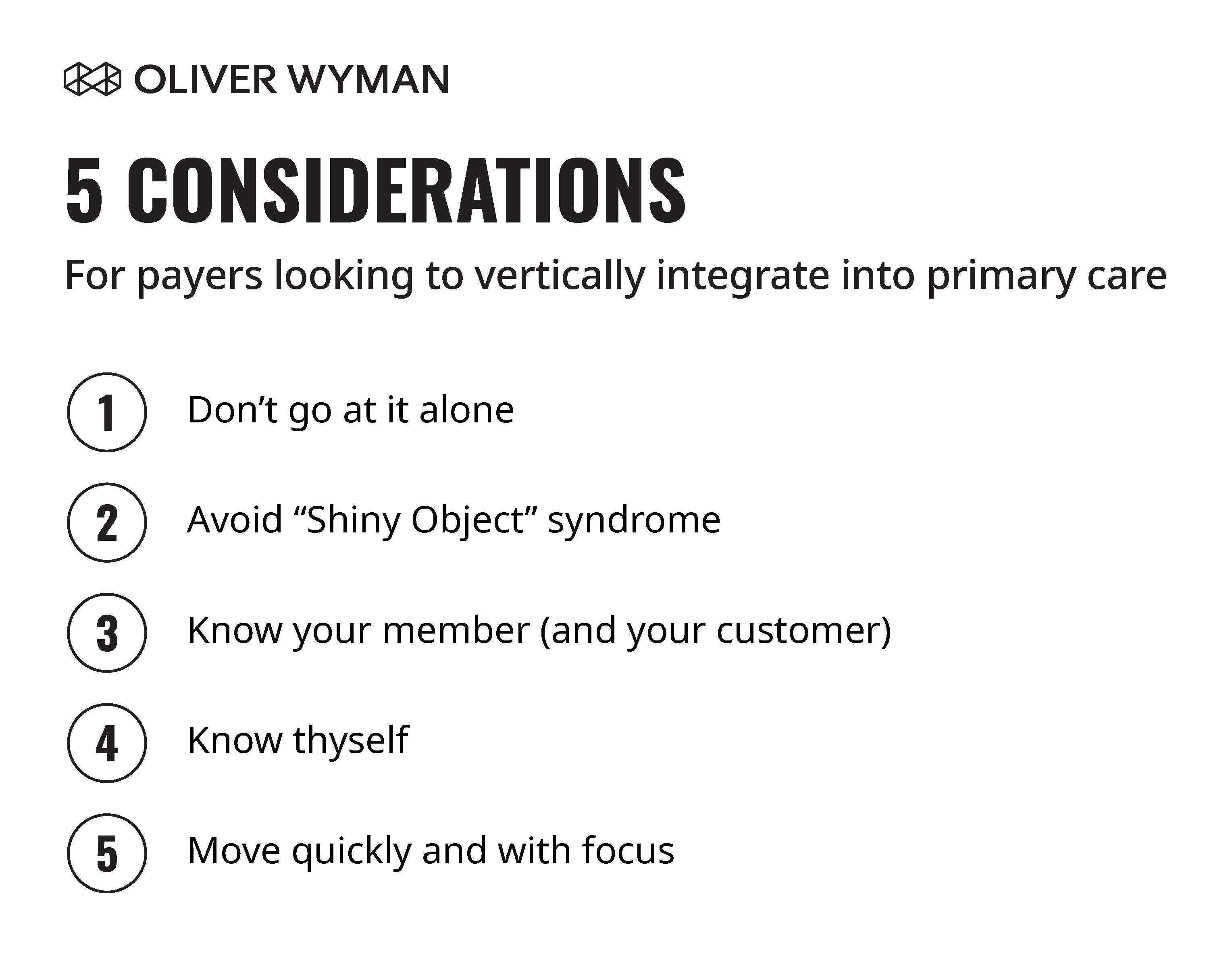Editor's Note: Health insurers are seeking to gain more control over care delivery. One of the ways they're doing so is by taking active ownership. Some insurers, for instance, are prompting patients to receive care at clinics the insurers themselves own. In a recent Wall Street Journal article called "Physicians, Hospitals Meet Their New Competitor: Insurer-Owned Clinics," Oliver Wyman's Health & Life Sciences Partner, Sam Glick, commented on what this means for the greater industry. Health plans want more leverage, he said, but are treading carefully. To continue this conversation, we present the following perspective from our Health & Life Sciences practice.
Primary care is having a moment right now. Primary care provider One Medical’s IPO has generated significant buzz. Elsewhere, innovative players include organizations like Forward, where patients pay $99 monthly for unlimited, high-tech, concierge primary care. Or Parsley, which provides direct primary care with a functional, whole-body approach. Walmart, a store that half of all Americans walk into every week, recently announced checkups for just $30 a pop. And this is just a small sample of the many players making bets on consumers’ evolving preferences for how they receive and pay for care.
With all this excitement, health plans want in, and they’re starting to move more intentionally into primary care. (Humana’s recently announced joint venture with Welsh, Carson, Anderson & Stowe to bring more value-based primary care to more Medicare patients is an example of this.) It’s no wonder that health plans see primary care as a way to improve their market position and overall performance. Primary care is healthcare’s “front door” for most consumers, with 71 percent of consumers nationally receiving care from a primary care physician within the past year. And, according to Oliver Wyman analysis, insurers can achieve 5 to 10 percent cost-of-care savings by deploying "lite" digital/virtually supported models, or up to 10 to 20 percent savings by deploying a combination of digital and in-person models.
When you get under the hood, there are a lot of different objectives health plans have when entering primary care: to improve performance of core insurance products, to enter or accelerate growth in lines of business like Medicare Advantage, to expand access in their communities, or to create an experience advantage versus the competition. Regardless of the ultimate strategic intent, here are five things for payers to keep in mind as they look to integrate into primary care.

1. Don’t Go At It Alone
Operating clinics seems like it should be straightforward – and yet, primary care is still generally a loss leader. Most systems that invest in primary care are banking on the increased referrals to specialty care within their system to make the economics work. And while health plans can use total cost-of-care savings to offset primary care clinic expenses, the goal should be to operate with efficiency. To access expertise and accelerate speed-to-market, consider partnering with an experienced clinic operator. For example, Blue Cross and Blue Shield of Kansas City (Blue KC) has partnered with Vera Whole Health for their Spira Care product. When establishing a partnership, be thoughtful about the structure that makes sense for what you’re trying to achieve. And invest time upfront to be explicit about roles and responsibilities.
2. Avoid "Shiny Object" Syndrome
Be clear about your primary motivations and design accordingly, keeping your thesis at the center of your design decisions. Set strategic objectives, understand your member population, determine where you truly want to be differentiated, and focus on influencing the factors related to those three. In particular, take advantage of those opportunities only accessible to an insurance company-owned primary care solution – for example, eliminating Utilization Management requirements, streamlining payment, and navigating patients to the best downstream care. Then, delegate the rest.
3. Know Your Member (And Your Customer)
Are you targeting the Medicare Advantage member? The Individual market? Commercial Group customers? Each population has different expectations and needs from primary care, and the model you launch must address these specifically if it’s to be successful. CareMore (owned by Anthem) has been effective because they address the specific high-touch needs of the Medicare population. Florida Blue has partnered with Sanitas to serve the individual market, with comprehensive services including medical, dental, and community support that together has delivered improved outcomes and experiences for their members.
4. Know Thyself
Humana’s Chief Executive Officer, Bruce Broussard, emphasized their latest primary care ventures have deliberately been designed to “not [be] a slave of internal Humana.” Entering into care delivery requires a departure from the core. The entity and governance structure of payers’ new initiatives should be deliberately designed to foster independence and promote innovation while ensuring strategic control is maintained at the highest level. Ensure that decision rights between any new entity or division and the parent company are explicit and agreed upon before beginning work. Insurers also need to enter care delivery with eyes wide open about potential impacts on the core business. Entering primary care will likely cause network abrasion. Make sure your entire organization is willing to tolerate this and prepare accordingly.
5. Move Quickly and With Focus
Insurers aren’t the only ones looking to increase their influence over the primary care market. Health systems are greatly increasing their primary care offerings, direct primary care and convenience care players continue to expand, and there is significant private equity and investor backing in the space. There is an urgency in establishing a primary presence while there is still room in the market to do so. Focusing on geographic density, not a dispersed model, will allow for efficiencies in some of the greatest roadblocks (real estate and provider acquisition) and for cross-staffing as scale is achieved, and will lower member acquisition costs as you achieve the network effect and word-of-mouth.


